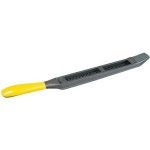Just for the heck of it, I thought it would be interesting to list our DIRTY LITTLE SECRETS with Sign Making. Here's our list (after 3 years experience):
1. Price...we are lucky to get $20 for a 6"x20" sign around here. It's an economic thing and most people are careful with their spending in our area of the country.
2. The Overarm Pin Router turned out NOT to be the machine for sign making. It was too difficult to get straight lines while holding onto the lumber. Plunging the bit with the foot pedal is great but we can do a better job with a hand held palm router. We will probably use the OPR for hogging out the background instead of trying to do the delicate lettering.
3. Using Marsh spray cans for painting the letters black works great. However, we've gummed up so many sheets of sandpaper trying to get the over-spray off the surface of the sign. We now use Acrylic paint and a brush to detail the black inside each letter cavity. Less sanding.
4. If you are not careful, the black color will bleed when trying to hand rub a poly coat or oil coat into your finished wood sign.
5. Then there are those router bits. Straight, V and round nose all have their place in sign making. However, figuring that out has been a process.
6. Which wood? Around here, people don't have an appreciation for exotic wood and won't pay for it. So...we use Pine. Plain ole crappy #2 pine and cutting around the knots.
7. Templates: We make ours and that has to be figured out too. After deciding on some shape to make into a template, it must be cut and finished before using it as your master template. We have learned much from this process. (Templates for the board shape, not letters.)
8. We can take any shape and font from Adobe Illustrator and print it out then iron it onto wood (we use laser printers). However, can you cut out those shapes and fonts? Some fonts lend themselves to sign making while others are not going to work well. We find ourselves using ARIAL ROUNDED BOLD mostly for inset letters and some fat font for outset lettering. Also, proper spacing between letters is a process that we had to learn the hard way.
9. Make $40k Making Signs? IMHO, that could be done with 3 or 4 employees making signs with a few distributors to sell for you.
Finally...We have made many things in our wood shop that were easier. Even nice wood cabinets were more straight forward and less taxing. IMHO, sign making has details throughout the process that can be challenging. In short, we have been humbled by the entire scenario of making a simple wood sign.
1. Price...we are lucky to get $20 for a 6"x20" sign around here. It's an economic thing and most people are careful with their spending in our area of the country.
2. The Overarm Pin Router turned out NOT to be the machine for sign making. It was too difficult to get straight lines while holding onto the lumber. Plunging the bit with the foot pedal is great but we can do a better job with a hand held palm router. We will probably use the OPR for hogging out the background instead of trying to do the delicate lettering.
3. Using Marsh spray cans for painting the letters black works great. However, we've gummed up so many sheets of sandpaper trying to get the over-spray off the surface of the sign. We now use Acrylic paint and a brush to detail the black inside each letter cavity. Less sanding.
4. If you are not careful, the black color will bleed when trying to hand rub a poly coat or oil coat into your finished wood sign.
5. Then there are those router bits. Straight, V and round nose all have their place in sign making. However, figuring that out has been a process.
6. Which wood? Around here, people don't have an appreciation for exotic wood and won't pay for it. So...we use Pine. Plain ole crappy #2 pine and cutting around the knots.
7. Templates: We make ours and that has to be figured out too. After deciding on some shape to make into a template, it must be cut and finished before using it as your master template. We have learned much from this process. (Templates for the board shape, not letters.)
8. We can take any shape and font from Adobe Illustrator and print it out then iron it onto wood (we use laser printers). However, can you cut out those shapes and fonts? Some fonts lend themselves to sign making while others are not going to work well. We find ourselves using ARIAL ROUNDED BOLD mostly for inset letters and some fat font for outset lettering. Also, proper spacing between letters is a process that we had to learn the hard way.
9. Make $40k Making Signs? IMHO, that could be done with 3 or 4 employees making signs with a few distributors to sell for you.
Finally...We have made many things in our wood shop that were easier. Even nice wood cabinets were more straight forward and less taxing. IMHO, sign making has details throughout the process that can be challenging. In short, we have been humbled by the entire scenario of making a simple wood sign.







